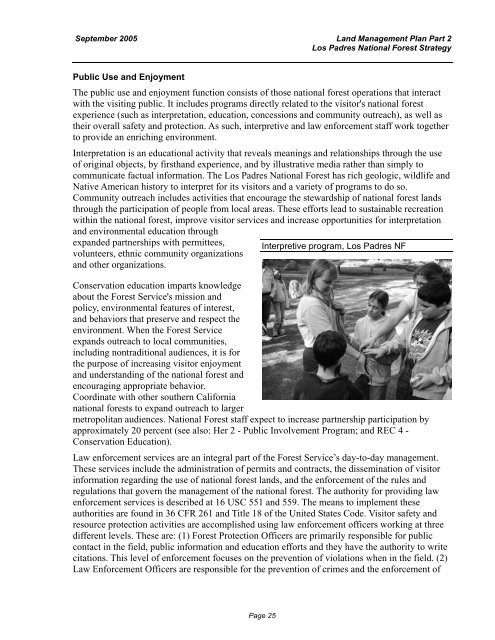Land Management Plan - Part 2 Los Padres National Forest Strategy
Land Management Plan - Part 2 Los Padres National Forest Strategy
Land Management Plan - Part 2 Los Padres National Forest Strategy
Create successful ePaper yourself
Turn your PDF publications into a flip-book with our unique Google optimized e-Paper software.
September 2005 <strong>Land</strong> <strong>Management</strong> <strong>Plan</strong> <strong>Part</strong> 2<br />
<strong>Los</strong> <strong>Padres</strong> <strong>National</strong> <strong>Forest</strong> <strong>Strategy</strong><br />
Public Use and Enjoyment<br />
The public use and enjoyment function consists of those national forest operations that interact<br />
with the visiting public. It includes programs directly related to the visitor's national forest<br />
experience (such as interpretation, education, concessions and community outreach), as well as<br />
their overall safety and protection. As such, interpretive and law enforcement staff work together<br />
to provide an enriching environment.<br />
Interpretation is an educational activity that reveals meanings and relationships through the use<br />
of original objects, by firsthand experience, and by illustrative media rather than simply to<br />
communicate factual information. The <strong>Los</strong> <strong>Padres</strong> <strong>National</strong> <strong>Forest</strong> has rich geologic, wildlife and<br />
Native American history to interpret for its visitors and a variety of programs to do so.<br />
Community outreach includes activities that encourage the stewardship of national forest lands<br />
through the participation of people from local areas. These efforts lead to sustainable recreation<br />
within the national forest, improve visitor services and increase opportunities for interpretation<br />
and environmental education through<br />
expanded partnerships with permittees, Interpretive program, <strong>Los</strong> <strong>Padres</strong> NF<br />
volunteers, ethnic community organizations<br />
and other organizations.<br />
Conservation education imparts knowledge<br />
about the <strong>Forest</strong> Service's mission and<br />
policy, environmental features of interest,<br />
and behaviors that preserve and respect the<br />
environment. When the <strong>Forest</strong> Service<br />
expands outreach to local communities,<br />
including nontraditional audiences, it is for<br />
the purpose of increasing visitor enjoyment<br />
and understanding of the national forest and<br />
encouraging appropriate behavior.<br />
Coordinate with other southern California<br />
national forests to expand outreach to larger<br />
metropolitan audiences. <strong>National</strong> <strong>Forest</strong> staff expect to increase partnership participation by<br />
approximately 20 percent (see also: Her 2 - Public Involvement Program; and REC 4 -<br />
Conservation Education).<br />
Law enforcement services are an integral part of the <strong>Forest</strong> Service’s day-to-day management.<br />
These services include the administration of permits and contracts, the dissemination of visitor<br />
information regarding the use of national forest lands, and the enforcement of the rules and<br />
regulations that govern the management of the national forest. The authority for providing law<br />
enforcement services is described at 16 USC 551 and 559. The means to implement these<br />
authorities are found in 36 CFR 261 and Title 18 of the United States Code. Visitor safety and<br />
resource protection activities are accomplished using law enforcement officers working at three<br />
different levels. These are: (1) <strong>Forest</strong> Protection Officers are primarily responsible for public<br />
contact in the field, public information and education efforts and they have the authority to write<br />
citations. This level of enforcement focuses on the prevention of violations when in the field. (2)<br />
Law Enforcement Officers are responsible for the prevention of crimes and the enforcement of<br />
Page 25
















